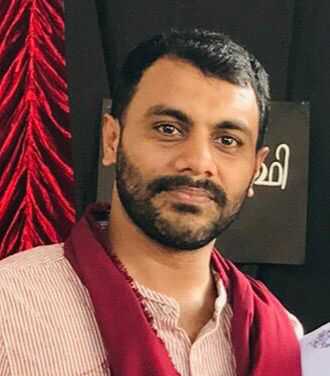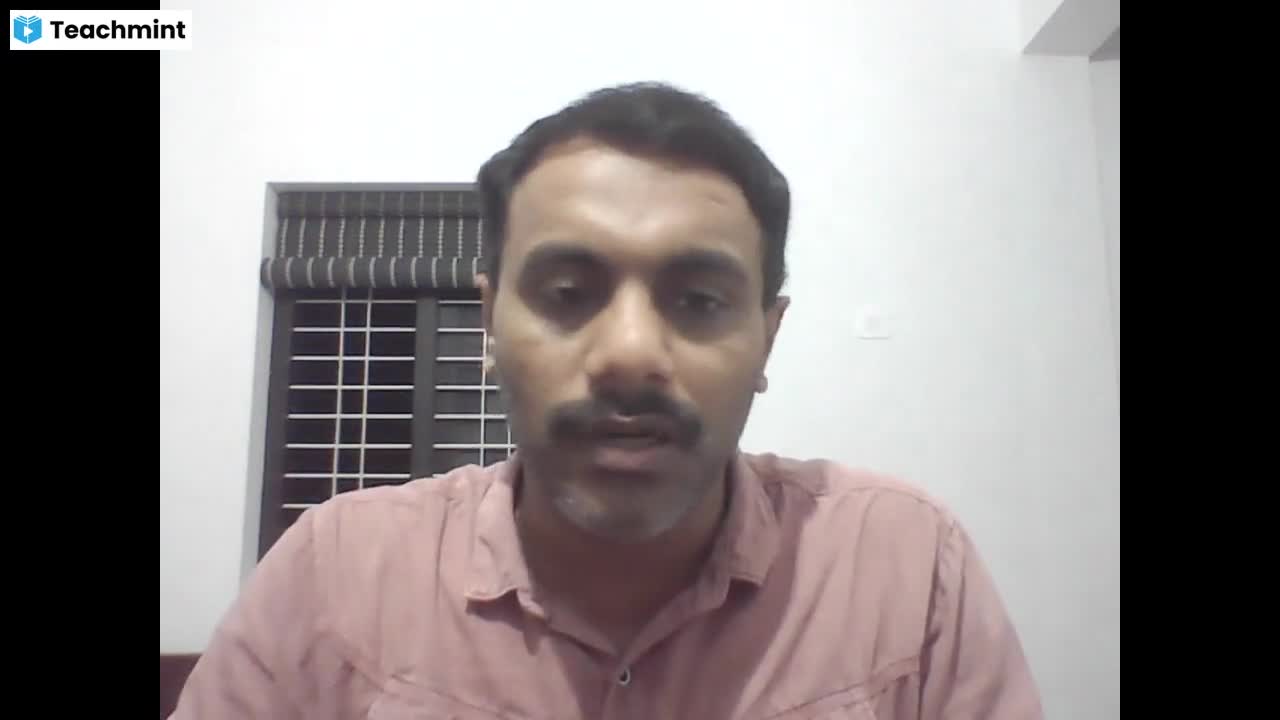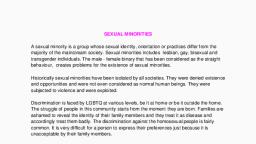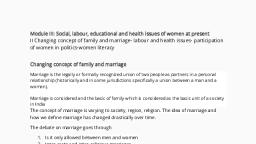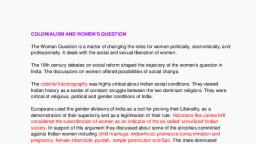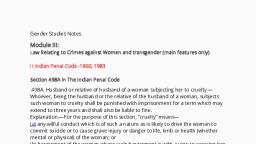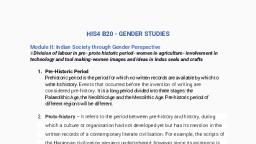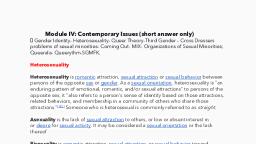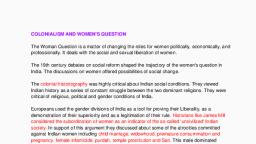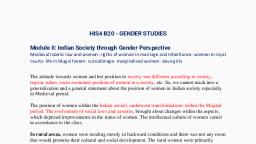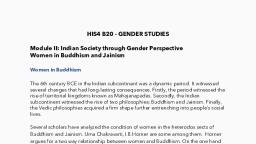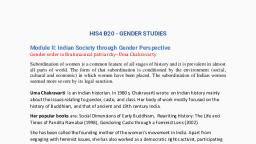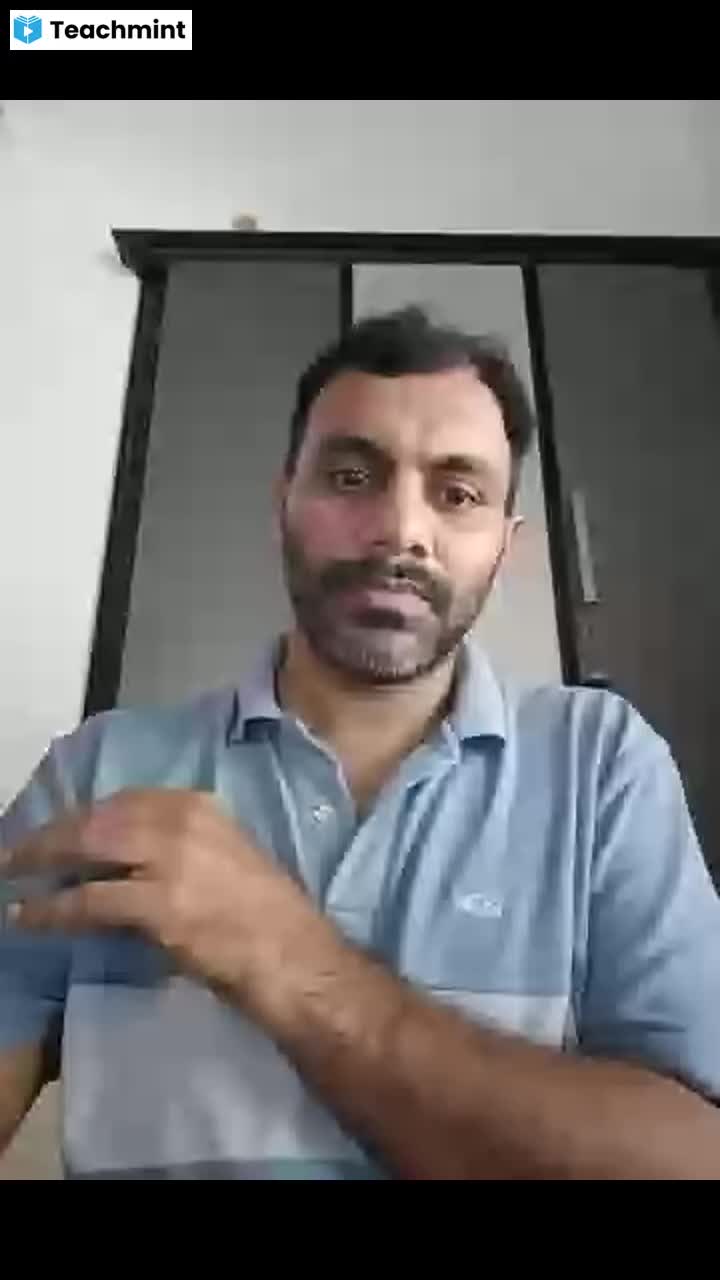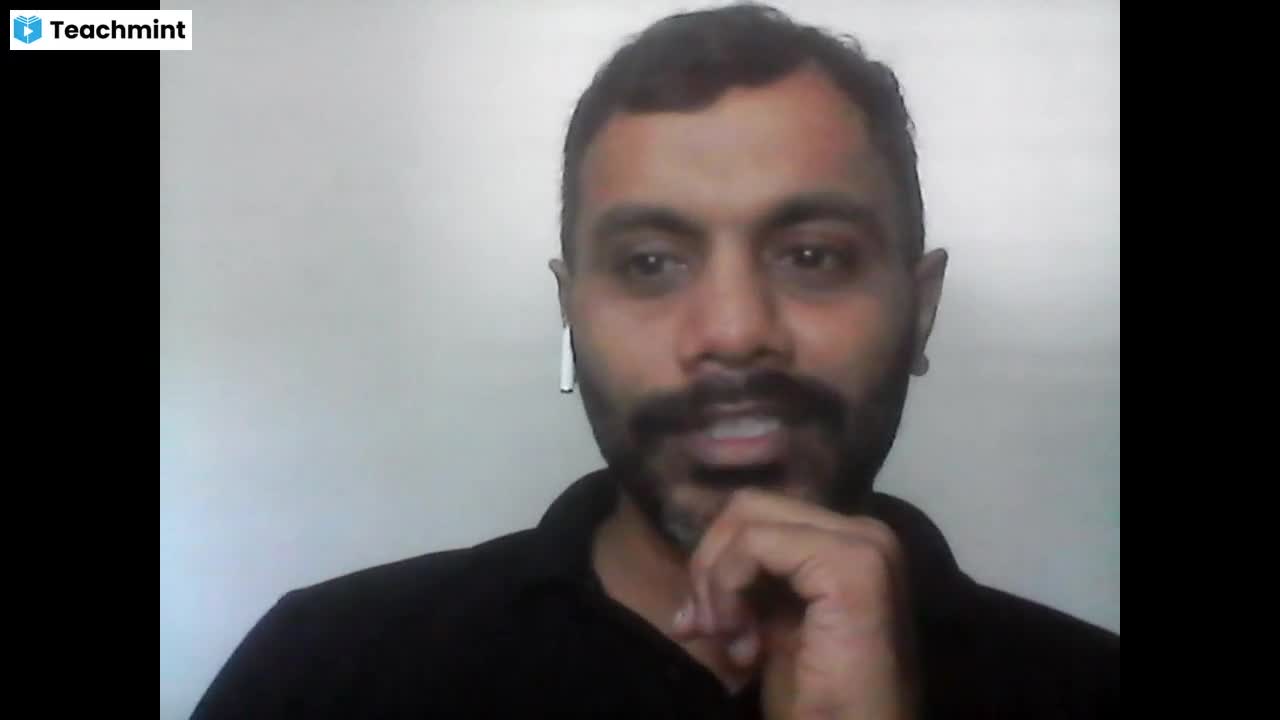Page 1 :
HIS4 B20 - GENDER STUDIES, Module II: Indian Society through Gender Perspective, Division of labour in pre- proto historic period- women in agriculture- involvement in, technology and tool making-women images and ideas in Indus seals and crafts, 1. Pre-Historic Period, Prehistoric period is the period for which no written records are available by which to, write its history. Events that occurred before the invention of writing are, considered pre-history. It is a long period divided into three stages: the, Palaeolithic Age, the NeolithicAge and the Mesolithic Age. Pre-historic period of, different regions will be different., 2. Proto-history – It refers to the period between pre-history and history, during, which a culture or organisation had not developed yet but has its mention in the, written records of a contemporary literate civilisation. For example, the scripts of, the Harappan civilization remains undeciphered, however since its existence is, noted in Mesopotamian writing, it is considered part of proto-history. Similarly,, Vedic civilisation from 1500-600 BCE is considered part of proto-history as well., Neolithic and Chalcolithic cultures are also considered part of proto-history by, archaeologists., 3. Historic Period – The study of the past after the invention of writing and the, study of literate societies based on written records and archaeological sources, constitute history, Prehistoric and Proto- Historic Periods in India – Ancient history can be divided into, different periods according to the tools used by people then., 1., 2., 3., 4., 5., , Paleolithic Period (Old Stone Age): 500,000 BCE – 10,000 BCE, Mesolithic Period (Late Stone Age): 10,000 BCE – 6000 BCE, Neolithic Period (New Stone Age): 6000 BCE – 1000 BCE, Chalcolithic Period (Stone Copper Age): 3000 BCE – 500 BCE, Iron Age: 1500 BCE – 200 BCE, , Division of labour in Indian Societies (pre and proto historic period), •, , The people of this age lived on hunting, fishing and food gathering initially but, later on they also domesticated animals and cultivated plants, thereby paving the, way for agriculture.
Page 2 :
•, •, •, •, , •, •, •, , The concept of division of labour explains the sexual division of labour in society, based on sex differences., The work done by women has always been treated as less important than men,, which is turn was dependent on the cultural, social, economic and historical, context of the society., In Indian society division of labour based on sex is very explicit., Ideologically males are viewed as producers who provide the material needs of, women and children; and women are treated as consumers whose place is in the, household and perform socially defined roles of cooking of food and caring of, children., The division of work is socially defined., It is generally believed that hunting in prehistoric societies was primarily carried, out by men and there was a strict division of labour during that period., Women are expected to perform household dominated activities, which are, supplementary and supportive to men folk (Jha 1998)., , Counter Arguments: women in agriculture, technology and tool making, • Women make essential contributions to the agricultural and rural economies in, all developing countries. Their roles vary considerably between and within, regions and are changing rapidly in many parts of the world, where economic and, social forces are transforming the agricultural sector. Rural women often, manage complex households and pursue multiple livelihood strategies. Their, activities typically include producing agricultural crops, tending animals,, processing and preparing food, working for wages in agricultural or other rural, enterprises, collecting fuel and water, engaging in trade and marketing, caring for, family members and maintaining their homes. Many of these activities are not, defined as “economically active employment” in national accounts but they are, essential to the wellbeing of rural households., • There were other studies which argued that the women in the primitive society, had a very active economic role. They were not only food gatherers but also were, the first managers of negligible surplus (Kosambi 1970), although this role was, later transferred to the patriarch or the tribal chief., • Earlier societies based on subsistence economies were more or less egalitarian, with both women and men toiled for subsistence., • According to DD Kosambi women were the first agriculturists, they the first, pottery maker sand textile producers., • The gender equation started changing with the family production and the tribal, ownership of land transformed into a system of peasant production and private, ownership of land with the use of animals for cultivation and transport (Boserup, 1970)., • The changes in the production accompanied by the changes in the position of, women, pushing them into a secondary status. The society became more, stratified in terms of several criteria which included gender too.
Page 3 :
•, , •, •, •, , Male group became the owner of land and taken the use of new and more, efficient equipment. Men are taught to operate animal driven equipment while, women continue to prepare the land with hand tools. Such discrimination, continued with the technological advancements and the use of mechanized, equipment. ( eg: While men ride tractors, women continued to do the tedious job, of weeding and transplanting in the agricultural fields.), Stone tools are important because they were the first recognizable object people, made, Recent studies indicates stone tool working is not just a male activity, but rather, that women probably had an active part in creating stone tools, women create a stone tool called a scraper to clean animal hides to be made into, bedding and clothing, , Women, Cast and Agriculture, •, •, , •, , •, , •, •, , The modernization in agriculture reduced the work burden of men. Women, continue to perform traditional hand operations unless their family’s income is, sufficient. (Ahmed 1985)., Women’s work contributes substantially to the occupational continuity of a caste, group. It is, of course, true that the growth of new professions & open, recruitment to occupations have been important aspects of social change in, Indian society. The picture of inalienable unchanging links between traditional, occupation &caste was in any case vastly overdrawn., At the same time, there are significant continuities in the link between caste, &occupation. Agriculture – although now open to all castes – still gives a distinct, identity to a large number of castes of “traditional” cultivators. Equally, some, other occupations remain the exclusive privileged of particular castes., A Brahmin, for instance, still performs the functions of the purohit (priest), for, upper & middle level castes. Among artisan castes of goldsmiths, blacksmiths,, potters & weavers a few members of the group at the very least are imparted the, necessary skills & make a living by the traditional craft. Finally, most ritually, polluting occupations – the curing & tanning of hides, the removal of dead, animals, scavenging & the activities of the barber, the washerman & the midwife, retain their association with specific castes. In these occupations, closely tied to, caste, the work of women carried out as members of households – the basic, units of production – is indispensable., It is difficult for weavers & potters to carry on the complex processes of their, craft without the continuous help of the women & children of the household, who, in turn have well-defined tasks., Women can also take on aspects of men’s work: it is not unusual for women, from a potter’s family to establish contacts with clients & go to the market to, assist with the selling of goods. Similarly, basket weaving is a joint activity of, men & women. In horticulture, women often carry the major burden of work.
Page 4 :
•, •, , In rural areas & small towns it is common for women from households of pretty, traders & shopkeepers to grind spices & prepare fries, fritters & preserves for sale, in the family shop., It has been found that parents may restrict the education of girls to avoid a, potentially uncomfortable situation in which the daughter develops distaste for, the traditional occupation of her caste. It then becomes difficult to get her, married into an appropriate family., , Women images and ideas in Indus seals and crafts, •, , •, , •, , •, , •, , A gender sensitive study of Indus Valley Civilization is extremely limited due to, the absence of written records. Hence it is not possible to develop a social, history of the period. Archaeological evidences alone cannot throw light to the, gender relations that might have existed among the people. However, archeologists and historians try to analyze various aspects of the civilization, from the available sources., A wide variety of objects made of unglazed baked clay (terra-cotta) such as urns, to children’s toys, whistles, and animal figures were found in Indus Valley. The, Indus Valley pottery was of good quality, and it was often red with black, geometric or flower designs. Stone carvers made sculptures out of soapstone, a, soft whitish stone with a “soapy” feel to it. Soapstone was also used to make the, seals that merchants used to mark their property., Excavations of Indus cities have produced much evidence of artistic activity., Such finds are important because they provide insights into the minds, lives, and, religious beliefs of their creators. Stone sculpture is extremely rare, and much of, it is quite crude., The figures are apparently all intended as images for worship. Such figures, include seated men, recumbent composite animals, or—in unique instances, (from Harappa)—a standing nude male and a dancing figure. The finest pieces, are of excellent quality., There is also a small but notable repertoire of cast-bronze figures, including, several fragments and complete examples of dancing girls, small chariots, carts,, and animals. The technical excellence of the bronzes suggests a highly, developed art, but the number of examples is still small. They appear to be Indian, workmanship rather than imports., , Women Images in Indus Seals: An Analysis, •, •, , The popular art of the Harappans was in the form of terra-cotta figurines. The, majority are of standing females, often heavily laden with jewelry, but standing, males—some with beard and horns—are also present., It has been generally agreed that these figures are largely deities (perhaps a, Great Mother and a Great God), but some small figures of mothers with children, or of domestic activities are probably toys.
Page 5 :
•, , •, , •, , Italian archeologists Paolo Biagi in his article 'Women in Ancient Sindh', Synthesizes the evidence of female clay figurines from Bronze Age sites in the, Indus Valley to highlight the social and cultural roles of women in that society., Although little is known of the true role women played in the Indus Valley, Civilization...there is little doubt that many of them represent fertility images, as, suggested by characteristics depicted in the statues. The hairstyles, ornaments, and dressing clearly indicate the important prominence assigned to women at, that time in what appeared to be a nearly egalitarian society., The ‘Dancing Girl’ : ‘Dancing Girl’ (dancing?) found from Mohenjo-Daro, it was, made up of Bronze, one of the bestknown artifacts from Indus valley. It has, approximately 4-inch high figure of a, dancing girl. This exquisite casting, depicts a girl whose long hair is tied in, the bun and bangles cover her left arm., Cowry shell necklace is seen around her, neck. Her right hand is on her hip and, her left hand is clasped in a traditional, Indian dance gesture. She has large, eyes and flat nose. And the features of, Mother Goddess includes, mainly found, in Mohenjo-Daro. These figures are, usually crude standing figures. Adorned, with necklaces hanging over the prominent breast and wearing a loin cloth and a, grid. The fan-shaped headdress with a cup like projection on each side is a, distinct decorative feature of the mother goddess. The pellet eyes and beaked, nose of the figure are very crude (constructed in a rudimentary way). Mouth is, indicated by a narrow opening., the bronze 'Dancing Girls' statuettes suggest specific, public activities played by, women at that time. Of extreme interest is also the occurrence of specific, naturalistic goddesses and their priestesses, which suggest that the Indus, people worshipped a goddess whose domain was the forest.", , An Assessment of Indus Seals and Women:, •, •, •, , All of the found Indus Valley female figures are in standing position., Most of them were obtained from rubbish structures or heaps of refuse, in, broken or burnt condition. This shows their temporary use., Their manufacture was also very complex; each specimen was made of 2 vertical, halves, from head to foot, which were later joined. Their arms are often absent.
Page 6 :
•, , Many of them show numerous and rich ornaments which consist of different, types of necklaces and pendants, while others are represented with the series of, neck rings., • Most figures are dressed in a sort of mini dress and turban and according to, scholars this might indicate the ethnic group or tribe to which they belong., 1. The earliest clay female figurine excavated from Mehrgarh , Pakistan and this, belongs to the 7th millennium before Christ when neolithic settlements were, established in that region. Female figurines show slight differences in the, manufacture and representation according to different periods., Many of them from 4000 BC onwards resemble fertility representation, which, some authors called mother goddesses as they show broad hips, a round body ,, short and thick legs suggesting pregnancy and motherhood., 2. Two very important female bronze statues were discovered from Mohenjodaro., They represent two young thin naked women, with few necklaces and a set of, bangles which cover the left arm of the first figurine. Together they are called, dancing girls. The first is portrayed in the act of dancing, with her legs slightly, bent, and her right hand resting on her hip., 3. A third type of female image is carved on some rare steatite seals. Some, scholars are of the opinion that this indicates the practice of cult rites. In these, seals a deity is carved as sitting in a Yogic position on a small throne, with her, knees stretched outwards and her hands on the knees, wearing a Buffalo horned, head - dress. She is always surrounded by numerous animals like tigers,, rhinoceros ,water buffaloes and imaginative unicorns. On another seal she is, standing between the branches of an Acacia tree, which may be representing a, forest . This is an unusual female image commonly called 'Lady of the Beasts ' ., Most of the scholars consider this to be a goddess., Different arguments, However a different argument has been put forward by Sharri R Clark and Shereen, Ratnagar regarding the interpretation of female figures of Indus Valley Civilization., Shari R Clark is of the opinion that there is no solid evidence other than preconceptions, that Indus female figurines are thought of as mother goddesses. Shereen Ratnagar, regards this labeling of objects as 'cultic objects' ie. mother goddesses as a simple, solution to the complex task of archaeological interpretation. She observes that these, clay figurines of women might be used in private rituals in homes. In Mohenjodaro the, evidence is even clear: most of the female figurines were discovered in the innermost, rooms of the houses. This shows the role of these figurines has been a private one.
